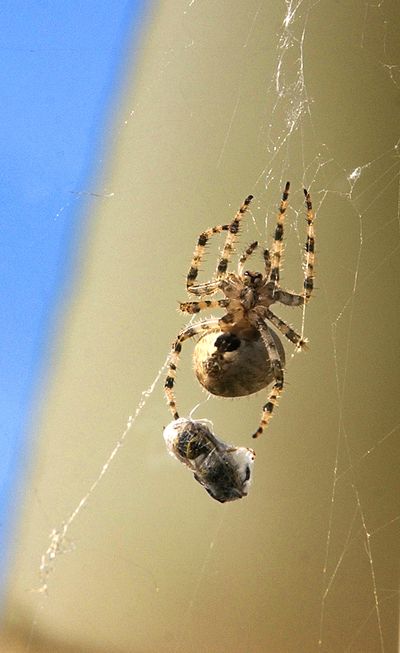Ask Dr. Universe: Why do garden spiders hang upside down in the middle of their webs?

Washington State University
Dear Dr. Universe: Why do garden spiders hang upside down in the middle of their webs? – Abree, 10, New Jersey
Dear Abree,
That’s a great observation. Garden spiders and other orb-weaver spiders crawl all around their webs, but we often see their heads pointing down toward the ground.
My friend Todd Murray, an entomologist at Washington State University, told me about a group of scientists who had a question a lot like the one you’ve asked.
These scientists used mathematical models to learn about orb-weaver spiders and how they move around the web. They discovered spiders that wait with their head down for prey can reach prey faster than spiders that wait with their head up for their prey.
While there are exceptions, this position gives spiders an advantage when getting food. Sometimes, prey will hit the top of the web but end up tumbling to the bottom of the web. A spider higher up on the web with its head facing down would be able to see prey below. Gravity also helps spiders as they run down the web.
Murray reminded me how different kinds of spiders can make different webs. Orb weavers tend to make webs in circle shapes. These spiders have parts called spinnerets located in their rear ends, or abdomens, that produce the silk.
Some orb-weavers might create a trap line with their silk, which attaches them to the middle of the web. When an insect hits the web, the trap line vibrates, and the spider can sense dinner has arrived. It might just be a fly, mosquito, moth or wasp.
As fall gets underway, orb weavers eat lots of insects and get bigger. You might identify an orb weaver from its brick red to orange body with white splotches. We see quite a few orb weavers in Western Washington at this time of year. You might notice more spiders and webs in your neighborhood, too.
We are still learning exactly why some spiders build certain kinds of webs. Murray said a wasp in Costa Rica has even revealed how a spider’s web designs can get hacked. The wasp glues an egg on the spider’s abdomen. When the egg hatches, the little larva attaches to the abdomen and starts living off the spider.
“That grub sits there and steals the nutrients from the spider like a vampire does, or a tick, or other blood-sucking creature,” Murray said. “As that grub grows on the spider, the spider does a really amazing thing.”
On the last night of its life, the spider start building a totally new kind of web that looks a bit like a hammock. Once the hammock is made, the spider puts the larvae into the hammock.
“It really does show you how those web-building abilities are hard-wired in the spiders and that they can be manipulated,” he said.
If you keep asking great questions like scientists do, maybe you’ll help us learn even more about the world of arachnids. In the meantime, keep an eye out for the spiders’ beautiful webs.
Sincerely,
Dr. Universe
Ask Dr. Universe is a project from Washington State University. Submit a question at askdruniverse.wsu.edu.